Recent Posts
The Importance of Professional Biohazard Cleanup for Homes and Businesses
3/11/2025 (Permalink)
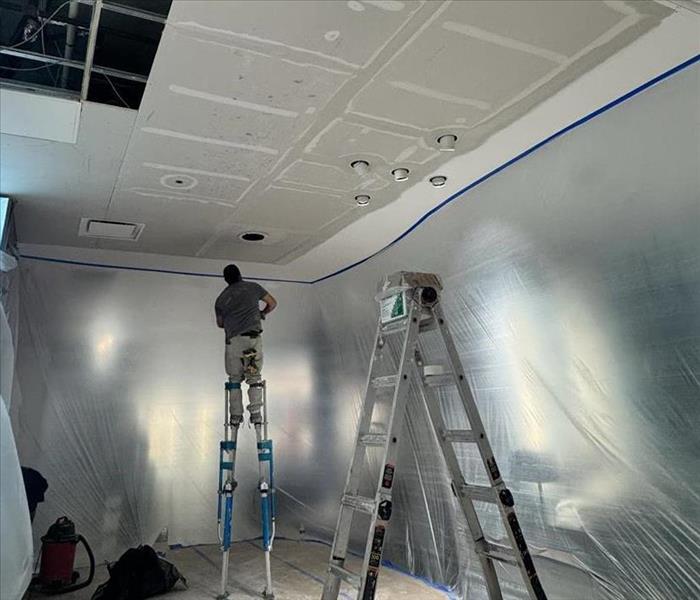 Employees working at a contained job site
Employees working at a contained job site
Biohazard situations can arise in many unexpected ways, from sewage backups and chemical spills to crime scenes and unattended deaths. These incidents require professional handling to ensure proper decontamination and minimize health risks. SERVPRO® of Town and Country specializes in biohazard cleanup, providing safe and efficient services to restore properties to a clean and livable condition.
What is Considered a Biohazard?
A biohazard is any biological material that poses a risk to human health or the environment. Some of the most common biohazard situations include:
- Sewage Backups: Raw sewage contains harmful bacteria, viruses, and parasites that can cause serious illness if not properly removed.
- Blood and Bodily Fluids: Crime scenes, traumatic events, or medical emergencies can leave behind biohazardous waste that requires specialized cleanup.
- Chemical and Hazardous Waste Spills: Industrial accidents or household chemical spills can release toxins that pose significant health and environmental risks.
- Hoarding Situations: Accumulated waste and neglected living conditions can lead to biohazard exposure, including mold, bacteria, and vermin infestations.
- Animal Waste and Remains: Rodents, pests, or deceased animals can introduce harmful pathogens into a property.
The Dangers of Handling Biohazards Without Professional Help
Attempting to clean up biohazards without proper training and equipment can be extremely dangerous. Exposure to bloodborne pathogens, toxic chemicals, or airborne contaminants can lead to infections, respiratory problems, and long-term health complications. Common risks include:
- Exposure to Infectious Diseases: Bloodborne pathogens such as hepatitis B, hepatitis C, and HIV can be present in contaminated fluids.
- Airborne Contaminants: Many biohazardous materials release airborne toxins that can affect indoor air quality and cause respiratory illnesses.
- Cross-Contamination: Without proper containment and disposal methods, biohazards can spread to other areas of the property, creating additional health risks.
How SERVPRO® of Town and Country Handles Biohazard Cleanup
SERVPRO® of Town and Country follows strict industry protocols to safely and thoroughly clean and decontaminate biohazardous environments. Our services include:
- Assessment and Containment: We assess the affected area, isolate contaminated zones, and implement safety measures to prevent further exposure.
- Personal Protective Equipment (PPE): Our trained technicians use specialized protective gear, including gloves, masks, and hazmat suits, to handle hazardous materials safely.
- Specialized Cleaning and Disinfection: Using industrial-grade cleaners, disinfectants, and air filtration systems, we eliminate harmful pathogens and contaminants.
- Safe Disposal of Biohazardous Waste: We adhere to all local, state, and federal regulations for the proper disposal of biohazard materials.
- Odor Removal and Air Quality Restoration: We use HEPA filtration and deodorization techniques to remove lingering odors and improve indoor air quality.
Why Choose SERVPRO® of Town and Country for Biohazard Cleanup?
- 24/7 Emergency Response: Biohazard situations require immediate attention. Our team is available around the clock to provide rapid response services.
- Compassionate and Discreet Service: We understand the sensitive nature of biohazard incidents and handle each case with professionalism and care.
- Certified and Experienced Technicians: Our team is IICRC-certified and trained in biohazard decontamination, following OSHA and EPA guidelines.
- Insurance Coordination: We work directly with insurance companies to simplify the claims process and reduce stress for property owners.
If you need professional biohazard cleanup in Town and Country, trust SERVPRO® of Town and Country to restore your property safely and efficiently. Contact us today for immediate assistance.
Why Choose Team Shaw for Emergency Restoration Services
12/2/2024 (Permalink)
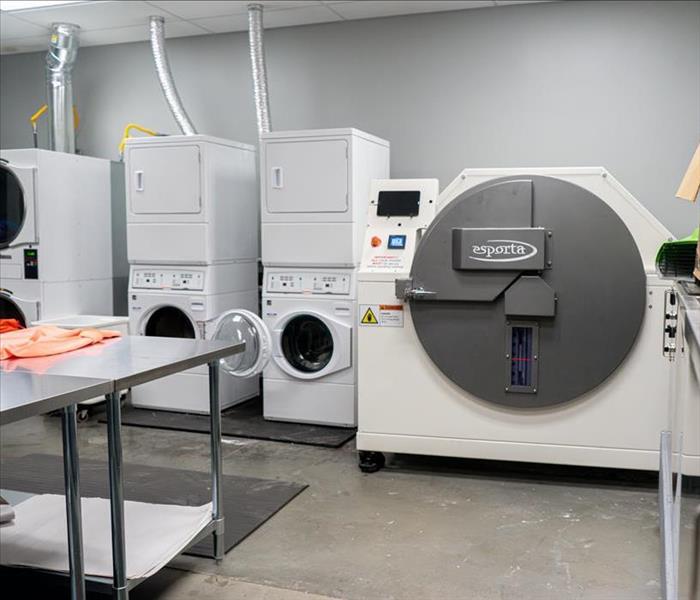 State of the art cleaning equipment at warehouse
State of the art cleaning equipment at warehouse
When disaster strikes, it can be overwhelming to face the damage caused by fire or water. Whether it’s a burst pipe, a kitchen fire, or storm-related flooding, time is of the essence to minimize the damage and start the restoration process. That’s where Team Shaw comes in. We’re proud to be the trusted partner for fire and water restoration in our community, offering swift, professional, and compassionate service when you need it most.
Comprehensive Fire and Water Restoration Services
At Team Shaw, we provide full-service restoration to handle every aspect of damage caused by fire or water, including:
- Water Damage Restoration: Rapid water extraction, structural drying, and repair to prevent mold and long-term damage.
- Fire Damage Restoration: Cleaning soot and smoke residues, odor removal, and repairing structural damage.
- Emergency Board-Up Services: Protecting your property from further damage or theft during the restoration process.
- Mold Remediation: Identifying and removing mold caused by water damage to restore a safe environment.
- Reconstruction Services: Rebuilding damaged areas to restore your property to pre-damage condition.
Why Choose Team Shaw?
1. 24/7 Emergency Response
Disasters don’t wait for business hours, and neither do we. Our team is available around the clock to respond to emergencies and start mitigating damage immediately.
2. Faster to Any Disaster
With our local presence and extensive resources, we guarantee a quick response to minimize damage and reduce restoration time. Our team arrives prepared with advanced equipment and a clear action plan.
3. Highly Trained Restoration Specialists
Our technicians are certified and extensively trained in fire and water restoration. From handling soot-covered walls to drying water-logged carpets, we use proven methods and advanced technology to ensure the best results.
4. Advanced Technology and Equipment
We use state-of-the-art equipment for water extraction, drying, air purification, and odor removal. Our advanced cleaning techniques restore your property and belongings with precision and care.
5. We Handle the Stress of Insurance
Navigating insurance claims after a disaster can be a daunting task. Our team assists with documentation and works directly with your insurance company to streamline the claims process, ensuring you receive the coverage you need.
6. Locally Owned and Operated with National Support
As a local business, we understand the specific needs of the Town & Country community. At the same time, we have access to extensive resources to handle large-scale disasters efficiently.
A Partner You Can Count On
Disasters can be devastating, but you don’t have to face them alone. Team Shaw is committed to restoring your property and peace of mind. With our expertise, compassion, and dedication to excellence, we make it our mission to help you recover as quickly as possible.
When fire or water damage strikes, choose Team Shaw. Contact us today for reliable, professional restoration services and experience the difference a trusted partner can make.
Expert Fire Restoration Services by Team Shaw of Town & Country
11/8/2024 (Permalink)
 Front desk at Team Shaw HQ
Front desk at Team Shaw HQ
Fire damage is among the most devastating events a property owner can face, leaving behind not just visible destruction but hidden dangers and persistent odors. For those in Town & Country, Team Shaw provides specialized fire restoration services that bring expertise, efficiency, and compassion to each project, ensuring properties are safe and fully restored. Here’s why Team Shaw of Town & Country is your trusted partner in fire restoration.
1. Swift and Strategic Response to Limit Damage
After a fire, time is critical. Smoke residues and soot can settle into surfaces, causing permanent staining and lingering odors. Team Shaw’s rapid response team is available 24/7, arriving promptly to assess and mitigate the damage. Their proactive approach helps prevent further structural damage and keeps restoration costs as low as possible.
2. Comprehensive Smoke and Soot Removal
Smoke and soot can penetrate walls, furniture, fabrics, and HVAC systems, leaving behind more than a visible stain. The microscopic particles from smoke can irritate respiratory systems and create long-term health risks if not addressed properly. Team Shaw uses advanced equipment and cleaning solutions to eliminate smoke particles and residue, restoring indoor air quality and ensuring all surfaces are safe and residue-free.
3. Odor Removal Technology
Odors from fire damage are notoriously challenging to eliminate. They can linger for months if not treated correctly. Team Shaw of Town & Country uses state-of-the-art deodorization techniques, such as hydroxyl generators and ozone treatments, to neutralize smoke odors at a molecular level, ensuring that your property smells fresh and clean once again.
4. Restoring Structural Integrity
Fires can weaken the structure of buildings, leaving behind compromised walls, floors, and roofs. Team Shaw’s fire restoration professionals conduct a thorough assessment of the building's stability, identifying areas that need repair or reinforcement. They bring in structural drying tools, dehumidifiers, and moisture meters to ensure no hidden damage is left unchecked, which helps restore the safety and integrity of your property.
5. Handling Personal Belongings with Care
In addition to structural damage, fires can impact personal belongings, many of which hold sentimental or practical value. Team Shaw takes great care with the contents of your home or business, using specialized cleaning, deodorizing, and restoration methods for items like electronics, documents, furniture, and personal items.
6. Compassionate Support and Guidance Throughout the Process
Recovering from a fire can be an emotional journey. Team Shaw understands this and is dedicated to providing clear communication and compassionate support at every step. Their team will work closely with you to navigate the insurance process, provide updates on the restoration timeline, and ensure all your concerns are addressed.
7. Local Expertise with National Standards
As part of the Town & Country community, Team Shaw has a deep understanding of the needs and challenges specific to the area. They are committed to providing top-tier fire restoration services that meet rigorous industry standards while staying attuned to the needs of their neighbors in Town & Country.
The Path to Recovery
Fire restoration requires a trusted partner who understands the intricacies of damage repair, odor removal, and emotional recovery. Team Shaw of Town & Country combines technical skill with heartfelt service, ensuring your property and peace of mind are restored. Whether it’s a small kitchen fire or a more extensive blaze, Team Shaw is here to help you rebuild and move forward with confidence.
After the Storm: Assessing Structural Damage with Precision
1/4/2024 (Permalink)
Severe storms can leave a trail of destruction in their wake, and assessing structural damage is a critical step in the aftermath. Whether it's wind, hail, or heavy rainfall, understanding the condition of your property is essential for prompt and effective repairs. In this blog, we'll guide you through a comprehensive process of assessing structural damage after a severe storm, ensuring that no hidden issues compromise the integrity of your home.
Safety First
Before conducting any assessment, prioritize safety. Ensure that the storm has completely passed and that it's safe to approach and inspect the property. Beware of downed power lines, unstable structures, and other hazards.
Exterior Inspection
Begin with a thorough exterior inspection. Look for visible signs of damage, including:
- Missing or damaged roof shingles.
- Dents or cracks in siding.
- Broken windows or damaged window frames.
- Leaning or damaged chimneys.
Roof Assessment
The roof is often the most vulnerable part of a structure during a storm. Carefully inspect the roof for:
- Missing or lifted shingles.
- Dents, cracks, or punctures in metal roofing.
- Water stains on the ceiling, indicating potential leaks.
- Use binoculars to assess high or steep roofs safely, and consider hiring a professional if you're uncomfortable with heights.
Check Gutters and Downspouts
Inspect gutters and downspouts for blockages caused by debris. Ensure that they are securely attached to the house and not sagging. Proper drainage is essential for preventing water damage.
Window and Door Evaluation
Examine windows and doors for damage, including:
- Broken glass or frames.
- Warped or misaligned doors.
- Cracks in door frames.
- Properly sealed windows and doors are crucial for maintaining the structural integrity of your home.
Foundation Inspection
Assess the foundation for signs of damage, such as:
- Cracks or fractures.
- Uneven settling.
- Water pooling around the foundation.
- Foundation issues can compromise the entire structure, so prompt attention is crucial.
Inspect the Attic
Ascend to the attic to check for:
- Leaks or water stains.
- Damaged insulation.
- Signs of pests or animals that may have entered during the storm.
- Identifying issues early can prevent further damage.
While a homeowner's assessment is crucial, some damage may be subtle or hidden. Consider hiring a professional structural engineer or a qualified home inspector to conduct a thorough evaluation, especially if you have concerns about the stability of your home. Document all visible damage with photographs and notes. This documentation will be essential for insurance claims and working with contractors.
Once you've assessed the damage, contact your insurance provider to report the incident. Provide them with detailed documentation and cooperate fully with their assessment process.
If immediate repairs are necessary to prevent further damage, secure temporary fixes. This may include tarping a damaged roof, boarding up broken windows, or addressing any other critical issues.
Assessing structural damage after a severe storm is a methodical process that requires attention to detail and a commitment to safety. By conducting a comprehensive evaluation, documenting damage, and seeking professional assistance when needed, you can ensure that your home is on the path to recovery. Swift action, coupled with a well-executed repair plan, will not only restore your property but also reinforce its resilience against future storms.
Fight Fire with Know-How: Cleaning Techniques for Different Types of Fire Damage
11/27/2023 (Permalink)
Fire damage may occur in many forms, including different types of fires, and can cause extensive damage to buildings and personal property. The fire restoration process typically involves cleaning, which is a critical step in restoring the property to its pre-fire condition. However, different types of fire damage require different cleaning techniques. In this blog, we will explore the various cleaning techniques for different types of fire damage.
Types of Fire Damage
There are three types of fire damage: dry, wet, and protein. Dry fire damage occurs when fires are fueled by wood, paper, or other organic materials. Wet fire damage occurs when the fire is fueled by synthetic materials or plastics, which produce thick, black smoke. Protein fire damage occurs when food is burned and produces a unique odor.
Dry Fire Damage
Dry fire damage is typically less severe than other types of fire damage. The most effective cleaning technique for dry fire damage is dry sponge cleaning. This technique involves using a sponge or cloth to remove soot and other debris. Using a vacuum cleaner is also recommended to carefully remove the soot residue.
Wet Fire Damage
Wet fire damage produces a lot of soot and ash, which can make cleaning difficult. Wet fire damage requires wet cleaning techniques, such as pressure washing and steam cleaning. The pressure washing technique is highly effective in removing soot and debris from surfaces. Steam cleaning is also efficient as it uses hot steam to break down and remove the ash and soot from affected areas.
Protein Fire Damage
Protein fire damage produces a sticky residue that clings to surfaces, making it difficult to remove. This type of fire damage requires cleaning agents specifically designed to break down the sticky residue. The cleaning technique for protein fire damage involves using a combination of degreasers and specialized detergents. Careful handling is necessary during this process to avoid damaging surfaces.
Restoration Services
In severe cases, hiring professional restoration services is recommended. Restoration companies have the expertise and equipment needed to handle any type of fire damage, including structural repairs, deodorization, and content restoration.
In conclusion, fire damage can cause widespread damage to property and objects. Depending on the type of fire damage, specific cleaning techniques are needed to remove soot and other residues from affected areas. Cleaning techniques such as sponge cleaning, pressure washing, steam cleaning, and specialized cleaning agents can effectively address different types of fire damage. For severe fire damage, professional restoration services are recommended. They provide a comprehensive approach to restoration, ensuring a complete recovery from fire damage. If you need help with cleaning and restoration after a fire, contact a professional restoration company with experience and knowledge in handling different types of fire damage.
Ensuring Employee Safety During Mold Removal: Best Practices to Follow
10/31/2023 (Permalink)
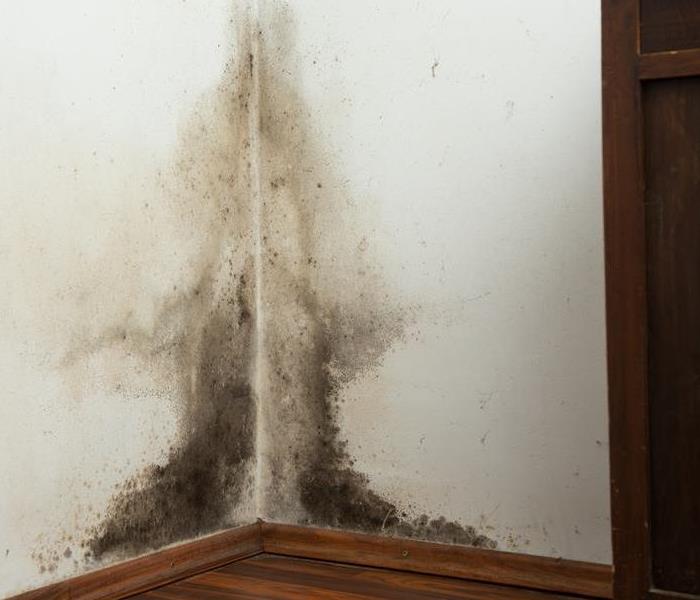 Ensure your property is safe for mold remediation. Communication is key!
Ensure your property is safe for mold remediation. Communication is key!
When it comes to mold removal in the workplace, prioritizing employee safety is paramount. While mold can pose health risks, this blog will solely focus on effective ways to maintain a safe working environment during mold remediation. By following these best practices, you can ensure the well-being and peace of mind of your employees throughout the mold removal process.
Conduct a Comprehensive Assessment
Before initiating any mold removal activities, carry out a thorough assessment of the affected areas. Identify the extent of the mold growth and determine the appropriate remediation strategy. This assessment will help you plan accordingly, ensuring that the necessary safety precautions are in place and minimizing potential risks to your employees.
Provide Proper Personal Protective Equipment
Equipping your employees with the appropriate Personal Protective Equipment (PPE) is crucial to their safety during mold removal procedures. This can include items such as gloves, goggles, respiratory protection, and disposable coveralls. Ensure that the PPE is of high quality, fits well, and is comfortable for extended use. Provide proper training on how to wear and use the PPE correctly to maximize its effectiveness in minimizing exposure.
Establish Containment Measures
During mold removal, it is crucial to establish proper containment measures to prevent the spread of mold spores to unaffected areas. Use physical barriers such as plastic sheeting to isolate the work area and restrict access. Install air scrubbers or containment negative air machines to filter and remove mold spores from the air within the contained area. By implementing effective containment measures, you can minimize the risk of cross-contamination and ensure the safety of employees in other parts of the workplace.
Prioritize Proper Ventilation
Maintaining proper ventilation is essential during mold removal. Ensure that the work area has adequate ventilation by using exhaust fans or opening windows and doors if weather permits. This will help remove airborne mold spores and freshen the air within the containment area. Proper ventilation is especially important when using chemicals or cleaning solutions. By prioritizing proper ventilation, you can enhance employee safety by reducing the concentration of airborne contaminants.
Conduct Regular Monitoring and Testing
Regular monitoring and testing of the work area during mold removal is vital to ensure employee safety. Periodically measure air quality and monitor for any signs of mold resurgence or cross-contamination. Conduct visual inspections to ensure that containment measures are intact. If necessary, seek assistance from professional mold remediation experts who can conduct air quality testing and provide additional guidance on maintaining employee safety throughout the process.
In addition to these best practices, clear and effective communication with your employees is crucial. Prior to the mold removal process, educate your staff about the procedures that will be carried out, the importance of their cooperation in adhering to safety protocols, and any temporary changes in their work environment. Encourage open dialogue and address any concerns or questions they may have. By fostering a culture of safety and ensuring that everyone is on the same page, you can create a collaborative and supportive atmosphere during the mold removal process, ultimately promoting the well-being and peace of mind of your employees. Remember, the safety of your employees should always be the top priority.
Water Damage Restoration Technology: Innovations and Advancements
10/23/2023 (Permalink)
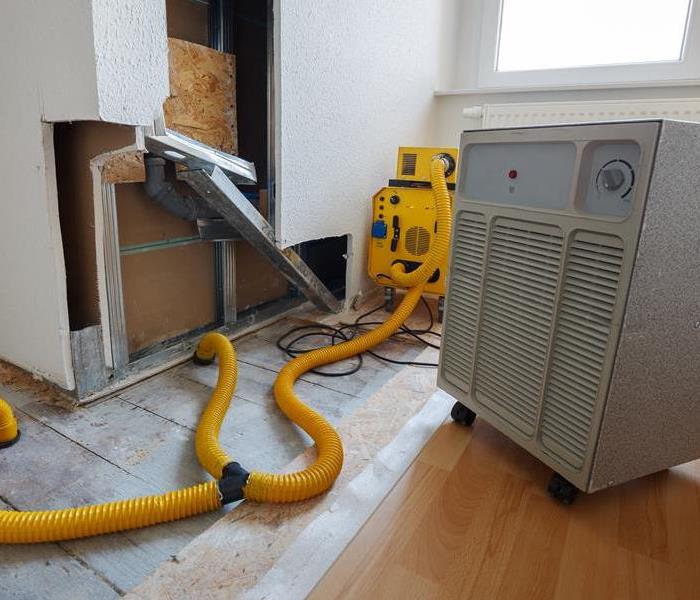 SERVPRO has technology unique in the restoration industry to restore your property back to pre loss conditions.
SERVPRO has technology unique in the restoration industry to restore your property back to pre loss conditions.
Water damage is a common issue for homeowners, and as technology advances, so do the tools and methods used to restore damaged properties. In this blog post, we will discuss some of the innovations and advancements in water damage restoration technology that are changing the industry for the better.
Moisture Detection
- Thermal Imaging Cameras: These cameras use infrared technology to detect and visualize temperature differences, allowing professionals to identify moisture in areas that may not be visible to the naked eye.
- Moisture Sensors: These handheld devices are used to identify moisture levels in building materials, such as drywall and framing, providing professionals with real-time data to inform their restoration practices.
Water Extraction
- High-Pressure Water Extraction Systems: These systems use powerful vacuums and pumps to remove water quickly and efficiently from flooded areas, reducing the likelihood of further water damage.
- Submersible Pumps: Submersible pumps are designed to remove large volumes of water, making them ideal for use in extreme flooding situations.
Drying Equipment
- Dehumidifiers: Dehumidifiers remove moisture from the air and surfaces, reducing humidity levels to promote faster drying times and prevent mold growth.
- Air Movers: Air movers are high-powered fans that circulate air to speed up the drying process and promote evaporation.
Air and Surface Sanitization
- UV-C Light Systems: Ultraviolet-C light systems use a special type of ultraviolet light that damages the DNA and RNA of bacteria and viruses, effectively killing them and sanitizing the air and surfaces.
- Ozone Generators: Ozone generators produce ozone, a gas that breaks down bacteria and viruses on surfaces and in the air.
Structural Drying
- Heat Drying Systems: Heat drying systems use specialized heaters and fans to increase the temperature and airflow in affected areas, promoting faster drying and reducing the likelihood of mold growth.
- Desiccant Dehumidifiers: Desiccant dehumidifiers use a special drying agent to remove moisture from the air, making them ideal for use in cold or humid environments where traditional dehumidifiers may not be as effective.
Remote Monitoring Technology
Environmental Monitoring Systems. These systems use sensors and cameras to monitor temperature, humidity, and other environmental factors in real-time, allowing professionals to adjust their restoration practices as needed. Remote monitoring apps allow homeowners and restoration professionals to monitor the drying process and receive alerts about changes in environmental conditions or potential equipment malfunctions.
Technology is transforming the water damage restoration industry, enabling professionals to respond to emergencies more efficiently and effectively than ever before. With an array of new tools and practices at their disposal, they can quickly assess and address water damage issues, minimizing the extent of the damage and reducing the cost of recovery. As technology continues to evolve, the potential for even more innovative and effective solutions will emerge, creating safer and more resilient homes and communities.
Navigating the Aftermath of Storm and Flood Damage in Southern Texas
9/26/2023 (Permalink)
In the dynamic coastal region of Southern Texas, the beauty of living near the water comes with a unique set of challenges, particularly when it comes to the aftermath of storm surge and flood damage. From hurricane seasons to sudden tropical storms, the potential for water-related damage is a reality for homeowners and property owners. This blog aims to provide valuable insights into the aftermath of storm surges and flood damage, helping you navigate the complexities and take proactive measures to protect your investment.
The Impact of Storm Surge and Flood Damage
Storm surge, driven by powerful winds and low-pressure systems, can lead to significant flooding in coastal areas. When combined with heavy rainfall from storms, the risk of flooding extends well beyond the immediate shoreline. The aftermath of storm surge and flooding can result in:
- Structural Damage: Floodwaters can weaken the foundation of buildings, erode soil, and compromise structural integrity.
- Electrical and Mechanical Systems: Water damage can disrupt electrical systems, appliances, and mechanical equipment, posing safety hazards.
- Health Concerns: Floodwaters can carry contaminants, sewage, and toxins, posing risks to occupants.
- Mold Growth: The combination of moisture and warmth after flooding creates a conducive environment for mold growth, which can lead to significant issues.
Taking Immediate Action
Understanding the importance of swift action after storm surges and flooding is crucial to mitigating further damage. Here are steps to consider:
- Ensure Safety First: Before entering a flooded area, ensure your safety by turning off electricity and gas connections.
- Document the Damage: Take photos and videos of the damage to provide evidence for insurance claims.
- Contact Your Insurance Company: Notify your insurance provider of the damage and start the claims process.
- Water Removal: If safe, begin removing standing water using pumps and wet/dry vacuums.
- Assessment by Professionals: Engage with restoration professionals to assess the extent of the damage, including structural and electrical concerns.
- Drying and Dehumidification: Thoroughly dry the affected areas to prevent mold growth. Dehumidifiers and proper ventilation are essential.
Navigating the Insurance Process
Navigating the insurance process after storm surge and flood damage can be complex. Here are tips to streamline the claims process:
- Review Your Policy: Understand the extent of your coverage and the specific terms related to storm damage and flooding.
- Document Thoroughly: Provide detailed documentation, including photos, videos, and written descriptions of the damage.
- Keep Records: Maintain a record of all communication with your insurance company, including names, dates, and notes of conversations.
- Use Professionals: Utilize professionals for assessments, repair estimates, and documentation to strengthen your claim.
- Be Patient: Insurance claims can take time to process, especially after widespread damage. Stay patient and persistent.
Preventing Future Damage
As Southern Texas is prone to storm surge and flooding, proactive measures can help minimize future damage:
- Elevate Electrical Systems: Elevate electrical outlets and switches to prevent water damage.
- Seal Vulnerabilities: Seal cracks and openings in the foundation and walls to prevent water intrusion.
- Landscape Considerations: Use native plants and proper grading to manage water runoff.
- Elevate Structures: Consider elevating structures in flood-prone areas to reduce potential damage.
- Purchase Flood Insurance: Invest in flood insurance to secure coverage specifically for flooding events.
Navigating the aftermath of storm surge and flood damage in Southern Texas requires vigilance, preparedness, and understanding. By taking immediate action, documenting damage, working with professionals, and staying informed about your insurance policy, you can protect your property and ensure a smoother recovery process. Furthermore, implementing preventive measures can help mitigate future damage, allowing you to enjoy the beauty of coastal living without compromising on safety and security.
Fire Safety 101: Protecting Your Home and Loved Ones from the Threat of Fire
8/14/2023 (Permalink)
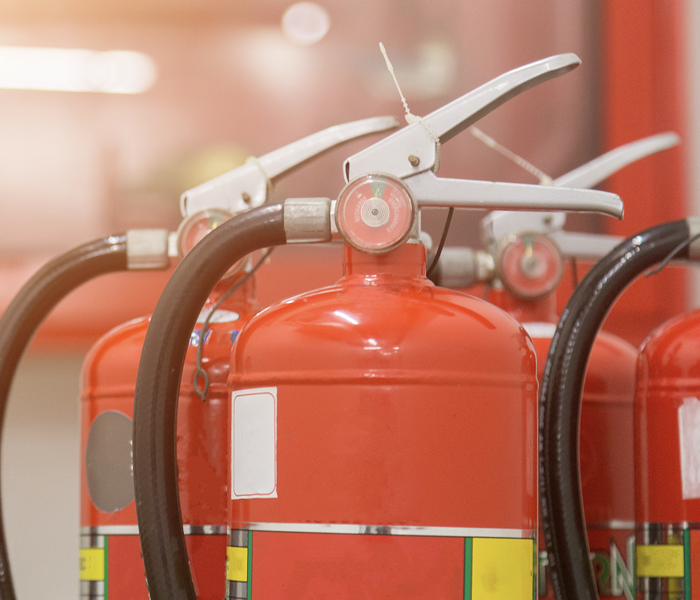 Have a fire extinguisher in your home or business incase of a fire.
Have a fire extinguisher in your home or business incase of a fire.
Keeping your home and loved ones safe from the threat of fire is a top priority. Fires can be devastating, causing property damage, injury, and even loss of life. However, by taking preventive measures and implementing fire safety practices, you can significantly reduce the risk of a fire occurring in your home. In this blog post, we will provide you with essential tips on how to prevent fire in your home and create a fire-safe environment.
Install Smoke Alarms
Smoke alarms are your first line of defense against fires. Install smoke alarms on every level of your home, including inside and outside bedrooms. Regularly test the alarms to ensure they are in good working condition, and replace batteries as needed. Consider upgrading to interconnected smoke alarms that will all sound an alarm if one is triggered.
Have a Fire Escape Plan. Create a fire escape plan for your household and make sure everyone knows what to do in case of a fire. Identify two ways to escape each room, establish a meeting point outside, and practice the plan regularly. Ensure that everyone knows how to crawl low under smoke and how to use a fire extinguisher if necessary.
Maintain Electrical Safety
Faulty wiring and electrical malfunctions can lead to electrical fires. Regularly inspect electrical cords and outlets for damage, and replace or repair any frayed or exposed wires. Avoid overloading outlets and use surge protectors for added safety. If you have older or outdated wiring, consider consulting an electrician for an upgrade.
Exercise Caution in the Kitchen. Cooking-related fires are a leading cause of home fires. Always stay in the kitchen while cooking, and never leave a hot stove unattended. Keep flammable items like curtains, potholders, and paper towels away from heat sources. Install a fire extinguisher rated for cooking fires (Class K) in the kitchen and know how to use it properly.
Practice Candle Safety
Candles can create a cozy atmosphere, but they also pose a fire hazard. Never leave candles unattended, and keep them away from flammable materials and out of reach of children or pets. Consider using flameless LED candles as a safer alternative.
Heating equipment, such as space heaters and furnaces, can lead to fires if not used correctly. Keep at least a three-foot clearance around heaters and other heat sources. Turn off space heaters when leaving the room or going to sleep. Have furnaces and chimneys professionally inspected and cleaned annually.
Properly Store Flammable Materials
Store flammable liquids, such as gasoline, paint thinners, and cleaning solvents, in a well-ventilated area away from heat sources and in approved containers. Keep them out of reach of children and store them according to the manufacturer's instructions.
If you have a fireplace or wood-burning stove, have it regularly inspected and cleaned to prevent the buildup of creosote, which can ignite and cause a chimney fire. Use a sturdy fireplace screen to prevent sparks from flying into the room.
Practice Safe Smoking Habits
If you smoke, do so outside and utilize designated outdoor areas away from flammable materials. Ensure cigarettes are fully extinguished in a sturdy ashtray and never dispose of smoking materials in planters or mulch.
Have fire extinguishers readily available in key areas of your home, such as the kitchen, garage, and near fireplaces. Make sure family members understand how to use the extinguishers and regularly check their expiration dates.
Preventing fire in your home requires a combination of preparedness, awareness, and proactive measures. By following these essential tips and implementing fire safety practices, you can create a fire-safe environment for you and your loved ones. Remember, fire safety is a priority, and investing time and effort in prevention today can save lives and protect your home tomorrow.
Understanding Secondary Water Damage: Causes, Effects, and Prevention
8/10/2023 (Permalink)
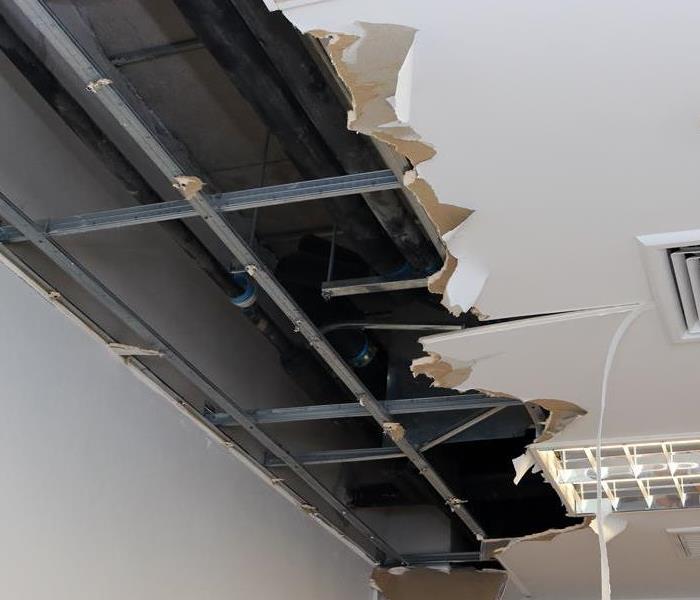 Secondary water damage can be costly. Act quick to prevent future damage.
Secondary water damage can be costly. Act quick to prevent future damage.
Water damage is a significant concern for homeowners and property managers, but it's not just the immediate effects of water intrusion that you need to worry about. Secondary water damage can occur if the initial water damage is not properly addressed or if it goes unnoticed for an extended period. In this blog, we will explore what secondary water damage is, its causes, effects, and most importantly, how to prevent it. Understanding and taking proactive measures against secondary water damage can save you from further costly repairs and potential health hazards.
Defining Secondary Water Damage
Secondary water damage refers to the additional harm that arises as a result of prolonged exposure to moisture or the improper drying of an initially affected area. It occurs when water seeps into building materials, such as drywall, flooring, or insulation, and causes damage over time. Secondary water damage can include mold growth, structural deterioration, weakened foundations, and compromised indoor air quality.
Causes of Secondary Water Damage
- Delayed or Inadequate Water Extraction: If the initial water intrusion is not promptly addressed or if inadequate measures are taken to extract the water, excess moisture can remain in the affected area. This prolonged exposure can lead to the development of secondary water damage.
- Poor Ventilation and Air Circulation: Insufficient airflow and ventilation impede the drying process. Without proper circulation, moisture can become trapped within walls, flooring, or other porous materials, leading to secondary damage.
- High Humidity Levels: High humidity levels in an environment affected by water damage can create a favorable breeding ground for mold growth and other microbial activity. Mold spores can quickly spread throughout the property and cause significant secondary damage.
- Plumbing Issues: If the initial water damage is caused by a plumbing issue that goes undetected or unrepaired, continuous water leakage can exacerbate the damage and result in secondary problems such as rotting wood, mold growth, and structural deterioration.
Effects of Secondary Water Damage
Excess moisture provides the ideal conditions for mold spores to thrive. Mold growth not only damages surfaces and materials but causes secondary damages. Prolonged exposure to moisture weakens the structural integrity of building materials. Wood may warp, swell, or rot, and drywall may deteriorate, compromising the stability and safety of the property.
Lingering moisture and mold growth contribute to unpleasant odors and poor indoor air quality. This can lead to discomfort, respiratory problems, and potential long-term health issues. Secondary water damage often requires more extensive repairs and restoration efforts compared to the initial damage. Mold remediation, structural repairs, and the replacement of damaged materials can significantly increase the overall cost of restoration.
Preventing Secondary Water Damage
- Act promptly: Address water damage immediately to minimize its impact and prevent secondary damage. Swiftly extract water, dry affected areas, and address the source of the water intrusion.
- Thoroughly Dry the Area: Ensure proper drying by using dehumidifiers, fans, and ventilation systems. Consider employing professional drying equipment and techniques for large-scale or severe water damage situations.
- Inspect for Hidden Damage: Conduct a thorough inspection of the affected area, including hidden spaces such as behind walls or under flooring. This helps identify any potential moisture pockets that may lead to secondary damage.
- Properly Ventilate: Maintain good airflow and ventilation throughout the property. Regularly inspect and clean ventilation systems, including HVAC units and air ducts, to prevent moisture buildup and mold growth.
- Monitor Humidity Levels: Use a hygrometer to monitor indoor humidity levels. Keep them below 60% to discourage mold growth and minimize the risk of secondary damage.
- Regular Maintenance: Conduct routine inspections of plumbing systems, roof, and foundation to detect and address any potential issues that may cause water damage.
Secondary water damage can be a costly and potentially hazardous consequence of water intrusion. By understanding its causes, effects, and prevention measures, you can take proactive steps to mitigate the risk of secondary damage. Remember, early intervention and preventive measures are key to preserving the integrity and safety of your home or building.





 24/7 Emergency Service
24/7 Emergency Service






